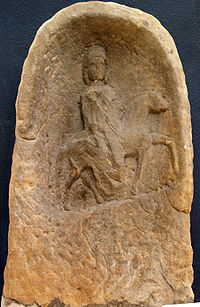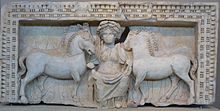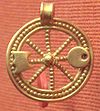- Epona
-
This article is about the goddess. For the character, see Epona (The Legend of Zelda).
In Gallo-Roman religion, Epona was a protector of horses, donkeys, and mules. She was particularly a goddess of fertility, as shown by her attributes of a patera, cornucopia, ears of grain and the presence of foals in some sculptures[1] suggested that the goddess and her horses were leaders of the soul in the after-life ride, with parallels in Rhiannon of the Mabinogion. Unusually for a Celtic deity, most of whom were associated with specific localities, the worship of Epona, "the sole Celtic divinity ultimately worshipped in Rome itself,"[2] was widespread in the Roman Empire between the first and third centuries CE.
Contents
Etymology of the name
Although known only from Roman contexts, the name Epona, 'Great Mare' is from the Gaulish language; it is derived from the inferred proto-Celtic *ekwos 'horse'[3] — which gives rise to modern Welsh ebol 'foal' — together with the augmentative suffix -on frequently, though not exclusively, found in theonyms (for example Sirona, Matrona, and the usual Gaulish feminine singular -a.[4] In an episode preserved in a remark of Pausanias,[5] an archaic Demeter too had also been a Great Mare, who was mounted by Poseidon in the form of a stallion and foaled Arion and the Daughter who was unnamed outside the Arcadian mysteries.[6] Demeter was venerated as a mare in Lycosoura in Arcadia into historical times.
Evidence for Epona
Fernand Benoit[7] found the earliest attestations of a cult of Epona in the Danubian provinces and asserted that she had been introduced in the limes of Gaul by horsemen from the east. This suggestion has not been generally taken up.
Although the name is in origin Gaulish, dedicatory inscriptions to Epona are in Latin or, rarely, Greek. They were made not only by Celts, but also by Germans, Romans and other inhabitants of the Roman Empire. An inscription to Epona from Mainz, Germany, identifies the dedicator as Syrian.[8] A long Latin inscription of the first century BCE, engraved in a lead sheet and accompanying the sacrifice of a filly and the votive gift of a cauldron, was found in 1887 at Rom, Deux-Sèvres, the Roman Rauranum. The inscription offers to the goddess an archaic profusion of epithets for a goddess, Eponina 'dear little Epona': she is Atanta, horse-goddess Potia 'powerful Mistress' (compare Greek Potnia), Dibonia (Latin, the 'good goddess')", Catona 'of battle', noble and good Vovesia.[9]
Her feast day in the Roman calendar was December 18 as shown by a rustic calendar from Guidizzolo, Italy,[10] although this may have been only a local celebration. She was incorporated into the Imperial cult by being invoked on behalf of the Emperor, as Epona Augusta or Epona Regina.
The supposed autonomy of Celtic civilisation in Gaul suffered a further setback with Fernand Benoit's study[11] of the funereal symbolism of the horseman with the serpent-tailed ("anguiforme") daemon, which he established as a theme of victory over death, and Epona; both he found to be late manifestations of Mediterranean-influenced symbolism, which had reached Gaul through contacts with Etruria and Magna Graecia. Benoit compared the rider with most of the riders imaged around the Mediterranean shores.
Perceptions of native Celtic goddesses had changed under Roman hegemony: only the names remained the same. As Gaul was Romanized under the early Empire, Epona’s sovereign role evolved into a protector of cavalry.[12] The cult of Epona was spread over much of the Roman Empire by the auxiliary cavalry, alae, especially the Imperial Horse Guard or equites singulares augustii recruited from Gaul, Lower Germany, and Pannonia. A series of their dedications to Epona and other Celtic, Roman and German deities was found in Rome, at the Lateran.[13] As Epane she is attested in Cantabria, northern Spain, on Mount Bernorio, Palencia.[14]
A bizarre euhemeristic account of the birth of Epona that does not reflect Celtic beliefs can be found in Plutarch's life of Solon: Giambattista Della Porta's edition of Magia naturalis (1589), a potpourri of the sensible and questionable, remarks, in the context of unseemly man-beast coupling, Plutarch's Life of Solon, in which he "reports out of Agesilaus, his third book of Italian matters, that Fulvius Stella loathing the company of a woman, coupled himself with a mare, of whom he begot a very beautiful maiden-child, and she was called by a fit name, Epona..."
Iconography
Sculptures of Epona fall into five types, as distinguished by Benoit: riding, standing or seated before a horse, standing or seated between two horses, a tamer of horses in the manner of potnia theron and the symbolic mare and foal. In the Equestrian type, common in Gaul, she is depicted sitting side-saddle on a horse or (rarely) lying on one; in the Imperial type (more common outside Gaul) she sits on a throne flanked by two or more horses or foals.[15] In distant Dacia, she is represented on a stela (now at the Szépmüvézeti Museum, Budapest) in the format of Cybele, seated frontally on a throne with her hands on the necks of her paired animals: her horses are substitutions for Cybele's lions.
In Roman texts and inscriptions
Epona is mentioned in The Golden Ass by Apuleius, where an aedicular niche with her image on a pillar in a stable has been garlanded with freshly picked roses.[16] In his Satires, the Roman poet Juvenal also links the worship and iconography of Epona to the area of a stable.[17] Small images of Epona have been found in Roman sites of stables and barns over a wide territory.
In Great Britain
The probable date of ca. 1400 BCE ascribed to the giant chalk horse carved into the hillside turf at Uffington, in southern England, is too early to be directly associated with Epona a millennium and more later, but clearly represents a Bronze Age totem of some kind. The English traditional hobby-horse riders parading on May Day at Padstow, Cornwall and Minehead, Somerset, which survived to the mid-twentieth century, even though Morris dances had been forgotten, may have deep roots in the veneration of Epona, as may the English aversion to eating horsemeat.[18] At Padstow formerly, at the end of the festivities the hobby-horse was ritually submerged in the sea.[19]
A provincial though not crude small (7.5 cm high) Roman bronze of a seated Epona, flanked by a small mare and stallion, found in England,[20] is conserved in the British Museum.[21] Lying on her lap and on the patera raised in her right hand are disproportionately large ears of grain; ears of grain also protrude from the mouths of the ponies, whose heads are turned towards the goddess. On her left arm she holds a yoke, which curves up above her shoulder, an attribute unique to this bronze statuette.[22]
The Welsh goddess Rhiannon rides a white horse and has many attributes of Epona. A south Welsh folk ritual call Mari Lwyd (Grey Mare) is still undertaken in December - an apparent survival of the veneration of the goddess. The pantomime horse is thought to be a related survival.
Today
On Mackinac Island, Michigan, Epona is celebrated each June with stable tours, a blessing of the animals and the Epona and Barkus Parade. Mackinac Island, Michigan does not permit any personal automobiles: the primary source of transportation remains the horse, so celebrating Epona has special significance on this island in the Upper Midwest.[23]
In popular culture
In games
- Link, from The Legend of Zelda series games, rides a horse named Epona in four installments: The Legend of Zelda: Ocarina of Time (1998), The Legend of Zelda: Majora's Mask (2000), The Legend of Zelda: Four Swords Adventures (2004) and The Legend of Zelda: Twilight Princess (2006). In Twilight Princess the player is given the option to change the name of the horse, but Epona is the default name.
An elf in the Japanese game Tears to Tiara is named Epona.
In literature
- Epona is the chief deity in P.C. Cast's Goddess of Parthalon series. Her priestess always rides a silver mare. The relevant books start with Bk. 1 Divine by Mistake and Bk. 5 is Brighid's Quest.
- In Morgan Llywelyn's novel, The Horse Goddess, Epona is a Celtic woman who possesses Druidic powers.
- In S.M. Stirling's Dies the Fire series of novels, the character of Rudi Mackenzie rides a large, majestic black mare named Epona, who will allow no one but him to ride her.
- In Rosemary Sutcliff's 1977 historical novel, Sun Horse, Moon Horse, the White Horse of Uffington is created as an invocation to Epona.
In music
- Enya has a song titled "Epona".
- Omnia (a Dutch PaganFolk band) has dedicated a song called "Epona" to the Celtic goddess, which appears on the album Sine Missione.
- The French Folk Metal band Heol Telwen has a song divided in two parts titled "Epona" in their album An Deiz Ruz.
Other
- As part of the European Space Agency Giotto Mission to Halley's Comet, an experiment by Irish Scientists from St. Patrick's College, Maynooth was named EPONA; this was also an acronym for Energetic Particle ONset Admonitor.[24][25]
See also
- Horse sacrifice
- White horse (mythology)
Notes
- ^ Salomon Reinach, "Épona", Revue archéologique (1895:163-95); Henri Hubert, Mélanges linguistiques offerts à M. J.Vendryes (1925:187-198).
- ^ Phyllis Pray Bober, reviewing Réne Magnen, Epona, Déesse Gauloise des Chevaux, Protectrice des Cavaliers in American Journal of Archaeology 62.3 (July 1958, pp. 349-350) p. 349. Émile Thevenot contributed a corpus of 268 dedicatory inscriptions and representations.
- ^ Compare Latin equus, Greek hippos.
- ^ Delmarre, 2003:163-164.
- ^ Pausanias, viii.25.5, 37.1 and 42.1 The myth was noted in Bibliotheke 3.77 and reflected also in a lost poem of Callimachus and in Ptolemy Hephaestion's "New History (Theoi.com: texts).
- ^ Karl Kerenyi, The Gods of the Greeks (1951) pp 184ff "Demeter, and Poseidon's stallion-marriages".
- ^ Benoît, F. (1950). Les mythes de l'outre-tombe. Le cavalier à l'anguipède et l'écuyère Épona. Brussels, Latomus Revue d'études latines.
- ^ CIL 13, 11801
- ^ G.S. Olmstead, "Gaulish and Celti-Iberian poetic inscriptions" Mankind Quarterly 28.4, pp339-387.
- ^ Vaillant, 1951.
- ^ Benoit 1950.
- ^ Oaks 1986:79-81.
- ^ Spiedel, 1994.
- ^ Simón.
- ^ Nantonos, 2004.
- ^ "respicio pilae mediae, quae stabuli trabes sustinebat, in ipso fere meditullio Eponae deae simulacrum residens aediculae, quod accurate corollis roseis equidem recentibus fuerat ornatum." (iii.27). In Robert Graves' translation of The Golden Ass, he has interposed an explanatory "the Mare-headed Mother" that does not appear in the Latin text; it would have linked Epona with the primitive mythology of Demeter, who was covered as a mare by Poseidon in stallion-form (see above); there is no justification for identifying Epona with Demeter, however.
- ^ Satire VIII lines 155-57, where the narrator derides a consul for his inappropriate interest in horses:
- interea, dum lanatas robumque iuuencum
- more Numae caedit, Iouis ante altaria iurat
- solam Eponam et facies olida ad praesepia pictas.
- ^ Theo Brown, "Tertullian and Horse-Cults in Britain" Folklore 61.1 (March 1950, pp. 31-34) p. 33.
- ^ Herbert Kille, "West Country hobby-horses and cognate customs" Proceedings of the Somerset Archaeological and Natural History Society 77 (1931)
- ^ Wiltshire is believable, but was added to the provenance, merely "trouvée en Angleterre", after the piece had been described in the sale catalogue of the Ferencz Pulszky collection, Paris, 1868.
- ^ "provincial, but not barbaric" is the assessment of the style by Catherine Johns, "A Roman Bronze Statuette of Epona", The British Museum Quarterly 36.1/2 (Autumn 1971:37-41).
- ^ Identified as a yoke by Catherine Johns 1971; its misidentification as a serpent has led to misleading identification of a "chthonic" Epona.
- ^ [http://Mackinac Island Lilac Festival.
- ^ Susan McKenna-Lawlor Profile Contribution to the Leonardo Space and the Arts Workshop on Sunday, March 21, 1999
- ^ McKenna-Lawlor, S. M. P., "Ireland's contribution to deep space missions" Irish Astronomical Journal (ISSN 0021-1052), vol. 18, March 1988, pp 179-183.
References
- Benoît, F. (1950). Les mythes de l'outre-tombe. Le cavalier à l'anguipède et l'écuyère Épona. Brussels, Latomus Revue d'études latines.
- Delamarre, X. (2003). Dictionaire de la Langue Gauloise. 2nd edition. Paris, Editions Errance.
- Euskirchen, Marion (1993). "Epona" Dissertation, Bonn 1994 (Sonderdruck aus: Bericht der Römisch-Germanischen Kommission 74.1993.)
- Evans, Dyfed Llwyd (2005–2007), Epona: a Gaulish and Brythonic goddess (Divine Horse)
- Green M. J. (1986), The Gods of the Celts, Stroud, Gloucestershire.
- Magnen, R. Epona (Delmas, 1953).
- Nantonos and Ceffyl (2004), Epona.net, a scholarly resource
- Oaks, L. S. (1986), "The goddess Epona", in M. Henig and A. King, Pagan Gods and Shrines of the Roman Empire (Oxford), pp 77–84.
- Reinach, Salomon (1895). "Épona". Revue archéologique 1895, 163-95,
- Simón, Francisco Marco, "Religion and Religious Practices of the Ancient Celts of the Iberian Peninsula" in e-Keltoi: The Celts in the Iberian Peninsula, 6 287-345, section 2.2.4.1 (on-line)
- Speidel, M. P. (1994). Riding for Caesar: the Roman Emperors' Horse Guards. Cambridge, Massachusetts, Harvard University Press.
- Thevenot, Emile 1949. "Les monuments et le culte d' Epona chez les Eduens," L'antiquité Classique 18 pp 385–400. Epona and the Aedui.
- Vaillant, Roger (1951), Epona-Rigatona, Ogam, Rennes, pp 190–205.
External links
Celtic mythology series Supra-regional Alaunus • Alisanos • Andarta • Anextiomarus • Artio • Aveta • Belenus • Belisama • Borvo • Brigantia • Camulus • Cernunnos • Cicolluis • Cissonius • Condatis • Damona • Matrona • Dis Pater • Epona • Erecura • Esus • Genii Cucullati • Grannus • Ialonus Contrebis • Lenus • Litavis • Loucetios • Lugus • Maponos • Matres • Mogons • Nantosuelta • Ogmios • Rosmerta • Segomo • Sirona • Sucellus • Suleviae • Taranis • Toutatis • Virotutis • VisuciusBritannia Gallia Aquitania Gallia Belgica Abnoba • Ancamna • Arduinna • Arvernus • Icovellauna • Inciona • Intarabus • Iovantucarus • Ritona • Veraudunus • Vindonnus • Vosegus • XulsigiaeGallia Celtica Gallia Cisalpina Gallia Narbonensis Germania Inferior Gallaecia Categories:- Ancient Gaulish and British goddesses
- Roman goddesses
- Fertility goddesses
- Animal goddesses
- Horses in culture and religion
Wikimedia Foundation. 2010.





